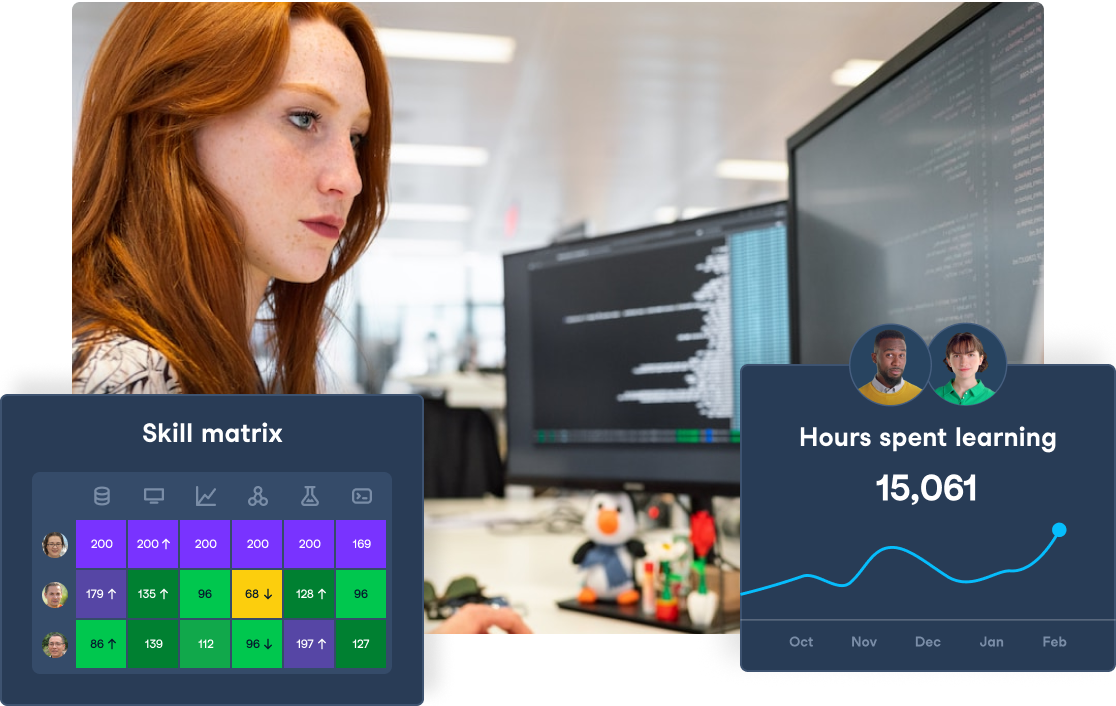Data scientists are highly sought after globally. The US Bureau of Labor Statistics suggests that this is a role that will grow around 35% (much faster than average) between 2022 and 2032. This equates to around 59,400 new openings over a decade to replace those exiting the workforce and fill new openings.
Writing a data scientist job description is an important step in attracting top talent to your organization. A well-written job description will clearly outline the responsibilities and qualifications required for the role, and provide insight into the company culture and values.
It's essential to be specific and concise, as well as to accurately convey the level of experience and expertise desired for the position. In this article, we will provide tips and guidelines for crafting a comprehensive and compelling data scientist job description.
For those who are looking at how to become a data scientist, we have a separate article that outlines everything you need to know. For those looking to develop their internal data teams, check out our webinar on Building Effective Data Teams.
Advance Your Team's Data Science Skills
Unlock the full potential of data science with DataCamp for Business. Access comprehensive courses, projects, and centralized reporting for teams of 2 or more.

Data Scientist Roles and Responsibilities
Let’s start by looking at what a data scientist does. While this will differ significantly from role to role, there are a few common threads that run throughout. On the whole, data scientists are responsible for using data to gain insights and make informed decisions. Their roles and responsibilities may include:
- Collecting and cleaning data: Data scientists often need to gather data from various sources, such as databases, websites, and surveys. They also need to ensure that the data is accurate and in a format that can be analyzed.
- Analyzing and interpreting data: Data scientists use statistical and machine learning techniques to analyze data and draw conclusions. They may also use visualization tools to present their findings in a clear and concise manner.
- Building and maintaining predictive models: Another important aspect of data science is the building and maintenance of predictive models to forecast future outcomes or identify trends. This may involve training and testing models, as well as optimizing them for accuracy and efficiency.
- Communicating results: Those working in this role need to be able to effectively communicate their findings to both technical and non-technical audiences. This may involve creating reports, presenting results to stakeholders, and collaborating with other team members.
- Working with cross-functional teams: Data scientists often work with teams of people with diverse skill sets, such as software engineers, product managers, and business analysts. They need to be able to collaborate effectively and translate their findings into actionable recommendations.
- Staying up-to-date with new technologies and methods: Data science is a rapidly evolving field, and those working in the profession need to stay current with new technologies and techniques to remain effective in their roles. This may involve continuing education, attending conferences, and participating in online communities.
What to include in Data Scientist Job Description
In this section, we will have a look at the elements you should include in each of the different parts of a data scientist job description.
Description
As we saw with the data engineer job description, this section should provide an introduction to the position you’re hiring for. Start with a brief description of the company and the reason why you’re looking for a new data scientist.
It’s worth summarising the kinds of tasks and projects the successful candidate will deal with, as well as some of the technical requirements of the job. Finally, in this section, you should provide the level of experience you need for this role. This will help job seekers rapidly decide whether to invest more time and energy in preparing a formal application.
Data Scientist Responsibilities
The data scientist role is often a highly technical one, relying on various tools and technologies to gain insights from data and make decisions based on those insights. The exact responsibilities will depend on your company and the existing team. However, they may include:
- Collecting and cleaning data from various sources, such as databases, websites, and surveys, using tools such as SQL and Python.
- Analyzing and interpreting data using statistical and machine learning techniques, such as linear regression and decision trees.
- Building and maintaining predictive models using techniques such as random forests and gradient boosting.
- Communicating your findings through technical reports and presentations using visualization tools such as Matplotlib and Seaborn.
- Deploy, test, validate, and maintain machine learning models in production by collaborating with data engineers and machine learning engineers.
- Perform extract, transform, load operations from data sources for modeling purposes.
- Design, perform and analyze A/B tests.
- Collaborating with cross-functional teams, including software engineers, product managers, and business analysts, to integrate your models into production systems.
Experience
As well as the relevant qualifications, you’ll want your data scientist applicants to have demonstrable experience in the field. While this doesn’t necessarily have to be in another data scientist role (depending on the level you’re hiring for), it can include education, individual projects, and an expansive portfolio of work.
You may want to outline here that your applicants need X+ years of relevant analytics experience to narrow your talent pool. Some additional factors to consider include:
- Strong technical skills, including proficiency in programming languages such as Python and SQL, as well as experience with statistical analysis and machine learning.
- Experience with big data technologies such as Hadoop and Spark.
- Experience with visualization tools such as Tableau.
Qualifications and Skills
Data scientists will need to be fluent in a variety of languages and tools. Again, the specifics will depend on the systems you use and the way the team is structured. Many data scientist job descriptions will specify that candidates need a degree in a technical field such as computer science, statistics, or engineering. However, this isn’t always necessary if the individual has the relevant skills and experience.
Some of the key skills and qualifications for a data scientist include:
- A relevant degree: While a degree is not always required for data science positions, many employers prefer to hire candidates who have a degree in a field such as computer science, mathematics, or statistics.
- Strong foundation in mathematics and statistics: Data scientists often use statistical methods to analyze data and draw insights, so a strong background in mathematics and statistics is essential.
- Proficiency in programming: Data scientists often use programming languages such as Python or R to manipulate and analyze data. Experience with these languages is, therefore, a must.
- Strong problem-solving skills: This role often requires the solving of complex problems using data, so the ability to think critically and creatively is important.
- Experience with data visualization: The successful candidate will need to effectively communicate their findings through visualizations and graphs.
- Experience with machine learning: Many data science roles involve the use of machine learning algorithms to analyze data and make predictions. Familiarity with these techniques is therefore important.
- Strong communication skills: Data scientists need to be able to clearly communicate their findings and insights to both technical and non-technical audiences.
- Relevant experience: While a degree can be helpful, many data science roles also require relevant work experience. This could include internships, research projects, or other practical experience working with data.
Extra Tips for Writing a Compelling Data Scientist Job Description
Even with a perfectly curated set of job descriptions and expectations, the sheer volume of job ads can bury your ad out of candidates’ sight. To keep your job descriptions compelling and clickable, consider the following:
- Include the salary range. A study by SMART Recruit Online found that when job ads include a salary range in them, they get over 30% more applicants. Provide a data engineer salary range that matches the requirements and seniority to bag your ideal candidate.
- Include benefits. Candidates are becoming more discerning with labor conditions and work-life balance. Make sure to include them to make the job opening more attractive.
- Give insight into workplace culture. Share details about the team, cultures, and values of the workplace. This will help candidates to envision themselves working with you and check if they align with your culture.
- Define the hiring process with HR. Candidates are keen to know what the hiring process will involve so they can prepare for interviews and meetings.
Data Scientist Job Description Template
We’ve included a link to an example of a data scientist job description template taken from a separate resource that you can adapt for your team’s hiring needs.
The template offers a solid starting point that you can alter to create more specific roles. For example, you could create a senior data scientist job description by adding in extra responsibilities, such as managing others, data integration work, and creating reports.
Find and Hire Data Talent with DataCamp Recruit
Job descriptions are key to addressing the question on how to find data engineers for your company. But the question on where to find data engineers is equally important.
There are many job search portals where you could publish your job opening, but we highly recommend you try DataCamp Recruit. We built this platform to help you find, hire, and scale your data times. DataCamp Recruit provides access to one of the largest sources of certified data professionals, with clear insights into the precise skills, experience, and expertise that you need to hire for. In particular, you will be able to:
- Describe your job and list the tech stack required.
- Access job seekers with the abilities you’re looking for are notified when your job is live.
- Filter candidates according to their technical skills and abilities.
- Request a chat with qualified candidates.
- Interview and hire candidates directly.
Final Thoughts
Crafting an effective data scientist job description is crucial for attracting top talent in this competitive field. By clearly outlining the roles and responsibilities, necessary qualifications, and key skills, you can ensure that your job posting stands out and draws in candidates who are the right fit for your organization. Remember to highlight the unique aspects of your company culture and the benefits you offer to make your listing more appealing.
Training 2 or more people? Check out our Business solutions
Get your team access to the full DataCamp library, with centralized reporting, assignments, projects and more


A senior editor in the AI and edtech space. Committed to exploring data and AI trends.
Data Scientist Job Description FAQs
What is the primary role of a data scientist?
A data scientist's primary role is to use data to gain insights and make informed decisions. This involves collecting, cleaning, analyzing, and interpreting data, building predictive models, and communicating results to both technical and non-technical audiences.
What are some common tools and technologies used by data scientists?
Data scientists often use programming languages such as Python and SQL, statistical analysis tools, machine learning frameworks, and data visualization tools like Matplotlib and Tableau. Big data technologies such as Hadoop and Spark are also commonly used.
How important is experience for a data scientist role?
Relevant experience is crucial for data scientist roles. This can include work experience in similar positions, internships, research projects, or practical experience working with data. Demonstrable experience with the required technical skills is often more important than formal education.
Why is it important to include a salary range in the job description?
Including a data scientist salary range in the job description can significantly increase the number of applicants. Studies have shown that job ads with salary ranges get over 30% more applicants. It also helps to attract candidates who are a better fit for the role based on their salary expectations.
What additional benefits should be highlighted in a data scientist job description?
Highlighting benefits such as work-life balance, remote work options, professional development opportunities, health benefits, and other perks can make the job opening more attractive to potential candidates. This helps in attracting top talent who are looking for more than just a salary.
